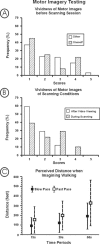Brain activations during motor imagery of locomotor-related tasks: a PET study
- PMID: 12731103
- PMCID: PMC6872050
- DOI: 10.1002/hbm.10103
Brain activations during motor imagery of locomotor-related tasks: a PET study
Abstract
Positron emission tomography (PET) was used to study the involvement of supraspinal structures in human locomotion. Six right-handed adults were scanned in four conditions while imagining locomotor-related tasks in the first person perspective: Standing (S), Initiating gait (IG), Walking (W) and Walking with obstacles (WO). When these conditions were compared to a rest (control) condition to identify the neural structures involved in the imagination of locomotor-related tasks, the results revealed a common pattern of activations, which included the dorsal premotor cortex and precuneus bilaterally, the left dorsolateral prefrontal cortex, the left inferior parietal lobule, and the right posterior cingulate cortex. Additional areas involving the pre-supplementary motor area (pre-SMA), the precentral gyrus, were activated during conditions that required the imagery of locomotor movements. Further subtractions between the different locomotor conditions were then carried out to determine the cerebral regions associated with the simulation of increasingly complex locomotor functions. These analyses revealed increases in rCBF activity in the left cuneus and left caudate when the W condition was compared to the IG condition, suggesting that the basal ganglia plays a role in locomotor movements that are automatic in nature. Finally, subtraction of the W from the WO condition yielded increases in activity in the precuneus bilaterally, the left SMA, the right parietal inferior cortex and the left parahippocampal gyrus. Altogether, the present findings suggest that higher brain centers become progressively engaged when demands of locomotor tasks require increasing cognitive and sensory information processing.
Copyright 2003 Wiley-Liss, Inc.
Figures







References
-
- Armstrong DM (1986): Supraspinal contribution to the initiation and control of locomotion in the cat. Prog Neurobiol 26: 273–361. - PubMed
-
- Bussel B, Roby‐Brami A, Néris O, Yakovleff A (1996): Evidence for a spinal stepping generator in man. Paraplegia 34: 911–92. - PubMed
-
- Calancie B, Needham‐Shropshire B, Jacobs P, Willer P, Zych G, Green BA (1994): Involuntary stepping after chronic spinal cord injury. Brain 117: 1143–1159. - PubMed
Publication types
MeSH terms
LinkOut - more resources
Full Text Sources
Medical

